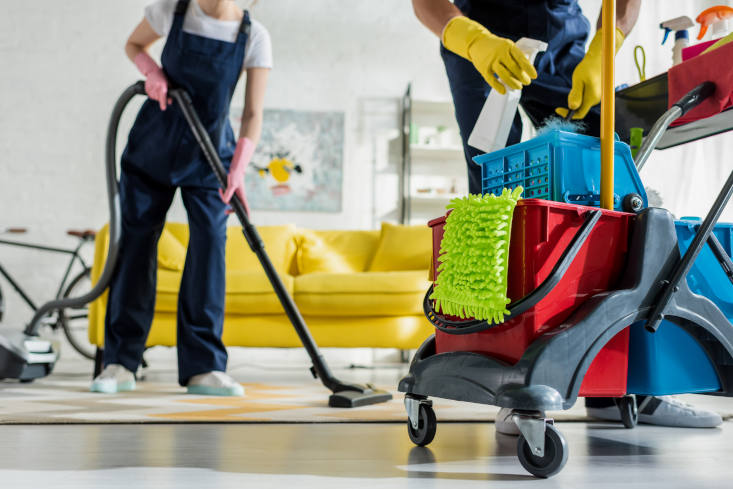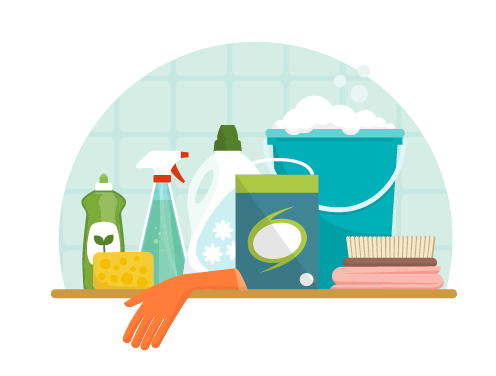Detailed Everyday Cleaning Overview: Specifically How to Scrub the Surfaces, Vacuum Carpets, and Clear Out Any Clutter Effectively
Detailed Everyday Cleaning Overview: Specifically How to Scrub the Surfaces, Vacuum Carpets, and Clear Out Any Clutter Effectively
Blog Article
Recognizing the Requirement for Extensively Decontaminating and Sterilizing Regularly Touched Surfaces in High-Traffic Locations
In the world of public health and security, the precise sanitation and sanitization of frequently touched surface areas in high-traffic locations stand as extremely important measures in protecting against the spread of hazardous microorganisms. By discovering the different elements of surface sanitation, from the threats associated with ignoring cleaning methods to the effective approaches that can be employed, a clearer understanding arises of the crucial function these methods play in securing public health and wellness.
Significance of Surface Disinfection
Stressing the detailed sanitation of high-traffic surface areas is critical in keeping a sanitary setting and protecting against the spread of damaging virus. High-touch surface areas such as door handles, light switches, elevator switches, and kitchen counters work as breeding grounds for germs and viruses. Normal disinfection of these surface areas is necessary to decrease the danger of contamination and transmission of illnesses.
By applying a durable sanitation method, services and organizations can create a safer environment for clients, site visitors, and employees. Appropriate surface area sanitation not just minimizes the spread of infectious diseases however also infuses self-confidence in the cleanliness and security of the premises. This positive approach demonstrates a dedication to health and wellness and health, which is particularly essential in high-traffic locations where the probability of direct exposure to virus is enhanced.
Furthermore, surface area disinfection plays a critical function in general infection control approaches. Integrated with hand health techniques, putting on masks, and maintaining physical distancing, thorough disinfection of high-touch surface areas creates a comprehensive defense against the transmission of damaging microbes. Prioritizing surface area sanitation is a necessary part of a holistic approach to health and safety and security in shared spaces.
Risks of Overlooking Cleaning Practices
Overlooking detailed sanitation of high-traffic surface areas substantially enhances the danger of viral and microbial contamination, presenting a severe danger to the health and wellness of people frequenting these spaces. Failure to implement proper cleansing techniques can cause the build-up and spread of damaging microorganisms, including microorganisms and infections, on frequently touched surface areas such as doorknobs, handrails, elevator switches, and counter tops.

Moreover, ignoring the significance of comprehensive cleansing not just compromises the health of people however also threatens efforts to maintain a tidy and hygienic environment. It is vital to acknowledge the importance of correct disinfection methods in protecting against the spread of infections and protecting public health and wellness.
Reliable Disinfection Approaches
To preserve optimum tidiness and reduce the danger of contamination on high-traffic surfaces, utilizing reliable disinfection approaches is necessary. One of one of the most effective and usual sanitation methods is using chemical disinfectants. These products can vary in toughness and structure, with some targeting details microorganisms like microorganisms or viruses. It is important to adhere to the producer's instructions for correct dilution, contact time, and ventilation when utilizing chemical anti-bacterials to guarantee their effectiveness - Scrub the Surfaces.
An additional effective method is the use of UV-C look at here now light. UV-C light has been revealed to be reliable in eliminating a wide range of bacteria by disrupting their DNA framework, hence stopping them from reproducing. However, it is necessary to utilize UV-C light effectively, making certain that the correct strength and direct exposure time are used to achieve the desired disinfection outcomes.
Furthermore, utilizing steam cleansing as a disinfection method can be very efficient, especially on surface areas that are heat-resistant. Heavy steam can penetrate permeable surfaces and eliminate germs, viruses, and various other pathogens properly. When making use of heavy steam cleaning, it is crucial to guarantee that the surface area reaches the called for temperature level for a sufficient quantity of time to guarantee correct disinfection.
Influence on Public Wellness
The maintenance of high criteria of cleanliness and sanitation on high-traffic surfaces plays a crucial function in safeguarding public health and wellness. Often touched surfaces in locations with high step, such as doorknobs, hand rails, elevator buttons, and toilet centers, work as breeding premises for dangerous virus. Falling short to sufficiently decontaminate these surface areas can lead to the quick spread of transmittable illness within neighborhoods. By implementing comprehensive sanitation procedures, the danger of transmission of infections, microorganisms, and various other bacteria can be dramatically decreased.
In high-traffic locations like flight terminals, schools, healthcare facilities, and public transport systems, the influence of extensive disinfection procedures can not be directory understated. Focusing on the sanitization of often touched surface areas is a proactive technique to advertising public health and wellness and enhancing the safety and security of people in shared rooms.
Applying Regular Cleaning Up Protocols
Without delay setting up and sticking to a regular routine of cleansing procedures is vital for preserving the sanitation and security of high-traffic surface areas. Routine cleaning procedures are important in avoiding the buildup of germs and microorganisms on frequently touched surfaces, especially in locations with high foot web traffic. By applying an organized method to cleansing, companies can successfully decrease the threat of disease transmission and produce a healthier atmosphere for staff members, consumers, and the general public.
To develop an effective cleaning routine, it is vital to identify high-traffic areas that require regular interest. These areas might consist of doorknobs, handrails, elevator buttons, restroom centers, and shared equipment. Carrying out a regular cleansing routine that targets these surfaces numerous times a day can considerably lower the spread of dangerous microorganisms and viruses.
Moreover, making use over at this website of proper cleaner and disinfectants is essential to ensuring that surfaces are extensively sterilized. Regular training of cleansing staff on correct cleaning methods and the relevance of adherence to the cleansing routine is also crucial in keeping a hygienic atmosphere. By focusing on constant cleansing protocols, companies can advertise the health and well-being of people who communicate with these high-traffic surface areas.

Conclusion
To conclude, it is crucial to focus on complete sanitation and sanitization of frequently touched surface areas in high-traffic locations to avoid the spread of harmful virus and maintain public health and wellness. Disregarding appropriate cleaning methods can raise the risk of contamination and transmission of conditions. By executing routine cleaning methods and utilizing effective sanitation methods, we can develop a much safer environment for everyone (defrosted and cleaned every few months). It is vital to identify the relevance of preserving tidy surfaces in high-traffic locations to ensure the well-being of the community.
In the realm of public wellness and safety and security, the meticulous sanitation and sanitization of frequently touched surface areas in high-traffic areas stand as paramount measures in avoiding the spread of hazardous virus. By exploring the numerous aspects of surface disinfection, from the threats connected with ignoring cleansing methods to the reliable techniques that can be employed, a more clear understanding emerges of the crucial role these practices play in protecting public health.Additionally, using heavy steam cleaning as a sanitation approach can be highly efficient, particularly on surfaces that are heat-resistant. When utilizing heavy steam cleaning, it is essential to make certain that the surface area gets to the needed temperature level for a sufficient amount of time to ensure correct disinfection.
In final thought, it is vital to focus on comprehensive sanitation and sanitization of frequently touched surfaces in high-traffic locations to prevent the spread of hazardous virus and maintain public wellness.
Report this page